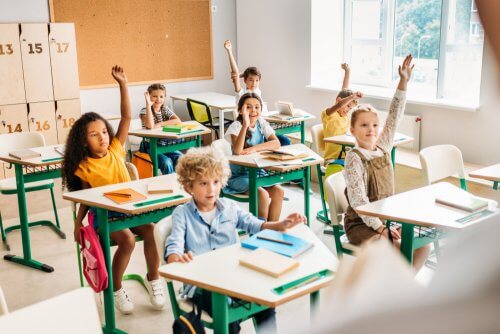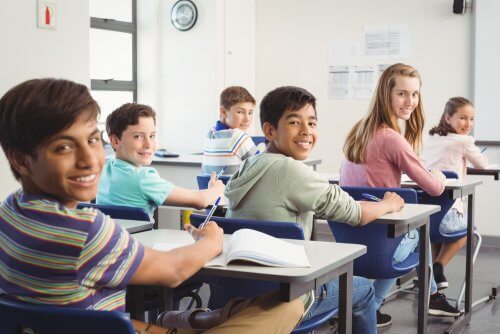How to Create a More Positive Classroom Environment


Written and verified by the teacher Azucena Fernández
The emotions and feelings of students are something that teachers need to be very aware of. How children feel on a given day plays an important role in their motivation, concentration, and even their ability to reason. Therefore, creating a more positive classroom environment is a fundamental goal that teachers should strive for.
Some days, teachers will encounter students that seem apathetic or a bit (or very) unhappy. And, in most cases, these emotions have nothing to do with the teachers themselves. Rather, they often have to do with these students’ friends, family, classmates, etc.
To get started, you can ask yourselves a few questions. Do the students seem happy to be in class? When class is over, are students smiling? Does it seem like they’re having a positive experience? A positive classroom environment can make a world of difference.
You can also think about your own experiences in attending classes as a student. Or you can think about some speaker that stands out in your mind. In most cases, you’ll think about instructors that transmitted a positive and coherent message.
Your goal, then, should be for this to be the status quo in your classroom. You’ll find three tips on how to create a more positive classroom environment below:

3 tips on creating a more positive classroom environment
Greet your students at the door when they come in
Many times, teachers have so many tasks to take care of that they forget this important detail. It’s very important to begin class on a positive note. In this sense, greeting your students enthusiastically as they come in sends a number of important messages. I see you… I’m glad you’re here… You’re important to me…
Students will come to note that their teacher is concerned about them and interested in their lives. We all feel good when people pay attention to us and show us respect.
A simple “hello” or “how’s it going?” can produce a type of positive, special connection with students. And this connection, in turn, will motivate students to be more attentive, concentrated, and enthusiastic about learning during class.
If children feel safe, they can take risks, ask questions, make mistakes, learn to trust, share their feelings, and grow.
– Alfie Kohn –
A dynamic classroom
Most students spend the majority of their day sitting in desks or at tables. So, if you ask them about how they feel in the classroom, you may find that many of them would prefer to get out of their seats every once in a while.
It’s not about randomly telling your students to stand up or having them walk laps around the classroom. Rather, it’s about allowing them to move about the classroom freely when they need to. So, whether it’s because they need to talk to a classmate that’s far away or because they need to approach your desk, give them that liberty.
Allowing students to move about freely in the classroom will make them feel much more comfortable and positive. Therefore, this will have a direct impact on the development of the entire class session.
The way you end your class is just as important as how you start it
What students often remember the most about a given session is the beginning and the end. So, another way to create a more positive classroom environment is to give students time at the end of the class to reflect on their experience. For example, they can keep a small journal where they write down positive reflections at the end of each session.

Another way to go about this is to divide students into small groups or pairs. Then, they can take a few minutes to tell one another about a positive part of their day or session.
To keep the groups or pairs from always being the same, you can establish certain rules. For example, ask them not to pair up with the same partner twice in a row. Or, you can establish groups by establishing different guidelines each day… For example, divide them by birth month, music preferences, what color they’re wearing, etc.
Conclusion on creating a more positive classroom environment
These are just some simple ideas that will help your students end each session or school day on a more positive note. What’s more, they’ll feel more prepared for their next class or activity. If teachers participate in the activity as well and share their experiences with one another, the process will be more complete and work even better.
Creating positive energy for each student in your class can make a huge difference in the way they view their educational experience. You can create an experience that they’ll remember and cherish forever.
“I’ve learned that people will forget what you said, people will forget what you did, but people will never forget how you made them feel.”
― Maya Angelou―
The emotions and feelings of students are something that teachers need to be very aware of. How children feel on a given day plays an important role in their motivation, concentration, and even their ability to reason. Therefore, creating a more positive classroom environment is a fundamental goal that teachers should strive for.
Some days, teachers will encounter students that seem apathetic or a bit (or very) unhappy. And, in most cases, these emotions have nothing to do with the teachers themselves. Rather, they often have to do with these students’ friends, family, classmates, etc.
To get started, you can ask yourselves a few questions. Do the students seem happy to be in class? When class is over, are students smiling? Does it seem like they’re having a positive experience? A positive classroom environment can make a world of difference.
You can also think about your own experiences in attending classes as a student. Or you can think about some speaker that stands out in your mind. In most cases, you’ll think about instructors that transmitted a positive and coherent message.
Your goal, then, should be for this to be the status quo in your classroom. You’ll find three tips on how to create a more positive classroom environment below:

3 tips on creating a more positive classroom environment
Greet your students at the door when they come in
Many times, teachers have so many tasks to take care of that they forget this important detail. It’s very important to begin class on a positive note. In this sense, greeting your students enthusiastically as they come in sends a number of important messages. I see you… I’m glad you’re here… You’re important to me…
Students will come to note that their teacher is concerned about them and interested in their lives. We all feel good when people pay attention to us and show us respect.
A simple “hello” or “how’s it going?” can produce a type of positive, special connection with students. And this connection, in turn, will motivate students to be more attentive, concentrated, and enthusiastic about learning during class.
If children feel safe, they can take risks, ask questions, make mistakes, learn to trust, share their feelings, and grow.
– Alfie Kohn –
A dynamic classroom
Most students spend the majority of their day sitting in desks or at tables. So, if you ask them about how they feel in the classroom, you may find that many of them would prefer to get out of their seats every once in a while.
It’s not about randomly telling your students to stand up or having them walk laps around the classroom. Rather, it’s about allowing them to move about the classroom freely when they need to. So, whether it’s because they need to talk to a classmate that’s far away or because they need to approach your desk, give them that liberty.
Allowing students to move about freely in the classroom will make them feel much more comfortable and positive. Therefore, this will have a direct impact on the development of the entire class session.
The way you end your class is just as important as how you start it
What students often remember the most about a given session is the beginning and the end. So, another way to create a more positive classroom environment is to give students time at the end of the class to reflect on their experience. For example, they can keep a small journal where they write down positive reflections at the end of each session.

Another way to go about this is to divide students into small groups or pairs. Then, they can take a few minutes to tell one another about a positive part of their day or session.
To keep the groups or pairs from always being the same, you can establish certain rules. For example, ask them not to pair up with the same partner twice in a row. Or, you can establish groups by establishing different guidelines each day… For example, divide them by birth month, music preferences, what color they’re wearing, etc.
Conclusion on creating a more positive classroom environment
These are just some simple ideas that will help your students end each session or school day on a more positive note. What’s more, they’ll feel more prepared for their next class or activity. If teachers participate in the activity as well and share their experiences with one another, the process will be more complete and work even better.
Creating positive energy for each student in your class can make a huge difference in the way they view their educational experience. You can create an experience that they’ll remember and cherish forever.
“I’ve learned that people will forget what you said, people will forget what you did, but people will never forget how you made them feel.”
― Maya Angelou―
All cited sources were thoroughly reviewed by our team to ensure their quality, reliability, currency, and validity. The bibliography of this article was considered reliable and of academic or scientific accuracy.
- Castro Pérez, M., & Morales Ramírez, M. E. (2015). Los ambientes de aula que promueven el aprendizaje, desde la perspectiva de los niños y niñas escolares. Revista electrónica educare, 19(3), 132-163. https://www.scielo.sa.cr/scielo.php?script=sci_arttext&pid=S1409-42582015000300132
- Flores Moran, J. F. (2019). La relación docente-alumno como variable mediadora del aprendizaje. Revista San Gregorio, (35), 174-186.
- Laslett, Robert, y Colin Smith. Effective classroom management: A teacher’s guide. Routledge, 2002.
- Maya, J. I. M., & Gómez, J. C. M. (2008). Estrategias didácticas para fomentar el pensamiento crítico en el aula. Revista Virtual Universidad Católica del Norte, (25).
- Murillo, F. J., Hernández-Castilla, R., & Martínez-Garrido, C. (2016). ¿ Qué ocurre en las aulas donde los niños y niñas no aprenden? Estudio cualitativo de aulas ineficaces en Iberoamérica. Perfiles educativos, 38(151), 55-70. https://www.scielo.org.mx/scielo.php?pid=S0185-26982016000100055&script=sci_arttext
- SJ, P. S. (2000). Diez mandamientos para ser un buen maestro. Revista Estudios Sociales, 33(122).
This text is provided for informational purposes only and does not replace consultation with a professional. If in doubt, consult your specialist.








